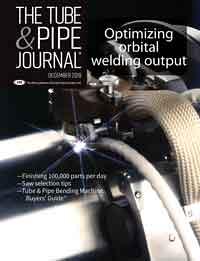Managing Director
- FMA
- The Fabricator
- FABTECH
- Canadian Metalworking
Categories
- Additive Manufacturing
- Aluminum Welding
- Arc Welding
- Assembly and Joining
- Automation and Robotics
- Bending and Forming
- Consumables
- Cutting and Weld Prep
- Electric Vehicles
- En Español
- Finishing
- Hydroforming
- Laser Cutting
- Laser Welding
- Machining
- Manufacturing Software
- Materials Handling
- Metals/Materials
- Oxyfuel Cutting
- Plasma Cutting
- Power Tools
- Punching and Other Holemaking
- Roll Forming
- Safety
- Sawing
- Shearing
- Shop Management
- Testing and Measuring
- Tube and Pipe Fabrication
- Tube and Pipe Production
- Waterjet Cutting
Industry Directory
Webcasts
Podcasts
FAB 40
Advertise
Subscribe
Account Login
Search
How the R&D Tax Credit can help auto component fabricators shift into high gear
Nearly every aspect of fulfilling a manufacturing contract—design, manufacture, and quality control—can qualify as research and development
- By Neil Shah
- November 29, 2019
- Article
- Manufacturing Software

The Research and Development Tax Credit saves U.S. businesses $10 billion every year and has helped manufacturers and suppliers across the country, including many in the automotive industry supply chain, to reinvest in their businesses. Getty Images
Manufacturers and suppliers of automotive components typically have a three-part focus in mind every day: deliver quality products that meet regulatory requirements while exceeding customer expectations.
Whether fabricating brake lines or manufacturing precision engine parts, these companies know that the process—from product design to testing to delivery—is a unique one that usually takes several iterations. Many part concepts require modification so that a single part is universal, fitting several similar models. When the model year changes, the process starts over again. In every case, getting the part just right for fit and function requires substantial cooperation with the OEM.
In many cases, automotive component manufacturers work on improvements in processes and product every day, which is exactly what the U.S. government wanted to reward when it created a government incentive that puts money back into the pockets of innovative U.S. businesses. In the 1980s Congress enacted the Research and Development Tax Credit (R&D Credit) to encourage U.S. businesses to innovate to help our country’s economy thrive while remaining a worldwide economic powerhouse. Judicial activity and legislative changes have expanded the government incentive throughout the years, including the most recent change, which eliminated the corporate Alternative Minimum Tax (AMT) and curbed the number of pass-through entities subject to individual AMT.
Thousands of companies in the U.S. are already taking advantage of the R&D Credit. However, those producing automotive components are in a unique position to claim the incentive because of their work in creating custom solutions for their clients.
Here are some examples of common activities that have qualified U.S. automotive component manufacturers and suppliers for the credit in the past:
Designing and developing automotive parts and components
Automating manufacturing operations with systems integration, control engineering, and robotics
Conducting first-article test inspections and scrutinizing parts to maintain quality assurance
Maintaining or upgrading existing devices
Exploring new or improved material applications and testing alternative uses of new steel alloys, aluminum alloys, and other metals
Make no mistake; these are just a few of the activities of automotive component businesses that might qualify for this powerful government incentive. From updating quality control systems to creating custom packaging for shipping parts, opportunities abound for Tier 1, 2, and 3 suppliers to claim the incentive.
Companies working in this space have been able to claim the credit successfully and repeatedly, allowing them to reinvest that newfound capital into their organization. This gives businesses the ability to keep pace with or even surpass competitors that might not have taken advantage of this government incentive.
Further, advancements in technology have enabled the testing and implementation processes to proceed more efficiently than ever. For example, the industrial internet of things has created an avenue for facilities and their managers to have more power at their fingertips to increase their businesses’ output.
Since 2015 millions of connectivity devices have been put into use, many of them by automotive component manufacturers and fabricators, to increase efficiencies and simplify operations. Businesses that leverage these devices to improve their operations can certainly see a reward through increased output or cost savings, but the organizations that are developing and implementing these tools also need to consider if the R&D credit is the right fit.
Those who remain skeptical about the tax incentive might be surprised to learn that the main concepts, research, and development, are actually more prevalent in niche industries than is commonly thought. The reason is simple: What these companies have in common is a commitment to improving products and processes, which is the behavior the R&D credit was created to incentivize. Regardless of whether you are a Tier 1, Tier 2, or Tier 3 automotive supplier, it is worth it to explore this program.
The incentive rewards companies up and down the supply chain. Whether they are recalculating the credits they are already claiming, or using the credit for the first time, these companies can shift into high gear simply by taking advantage of the R&D Credit.
About the Author

About the Publication
Related Companies
subscribe now

The Tube and Pipe Journal became the first magazine dedicated to serving the metal tube and pipe industry in 1990. Today, it remains the only North American publication devoted to this industry, and it has become the most trusted source of information for tube and pipe professionals.
start your free subscription- Stay connected from anywhere

Easily access valuable industry resources now with full access to the digital edition of The Fabricator.

Easily access valuable industry resources now with full access to the digital edition of The Welder.

Easily access valuable industry resources now with full access to the digital edition of The Tube and Pipe Journal.
- Podcasting
- Podcast:
- The Fabricator Podcast
- Published:
- 04/16/2024
- Running Time:
- 63:29
In this episode of The Fabricator Podcast, Caleb Chamberlain, co-founder and CEO of OSH Cut, discusses his company’s...
- Trending Articles
Zekelman Industries to invest $120 million in Arkansas expansion

3D laser tube cutting system available in 3, 4, or 5 kW

Corrosion-inhibiting coating can be peeled off after use

Brushless copper tubing cutter adjusts to ODs up to 2-1/8 in.

HGG Profiling Equipment names area sales manager

- Industry Events
16th Annual Safety Conference
- April 30 - May 1, 2024
- Elgin,
Pipe and Tube Conference
- May 21 - 22, 2024
- Omaha, NE
World-Class Roll Forming Workshop
- June 5 - 6, 2024
- Louisville, KY
Advanced Laser Application Workshop
- June 25 - 27, 2024
- Novi, MI


























